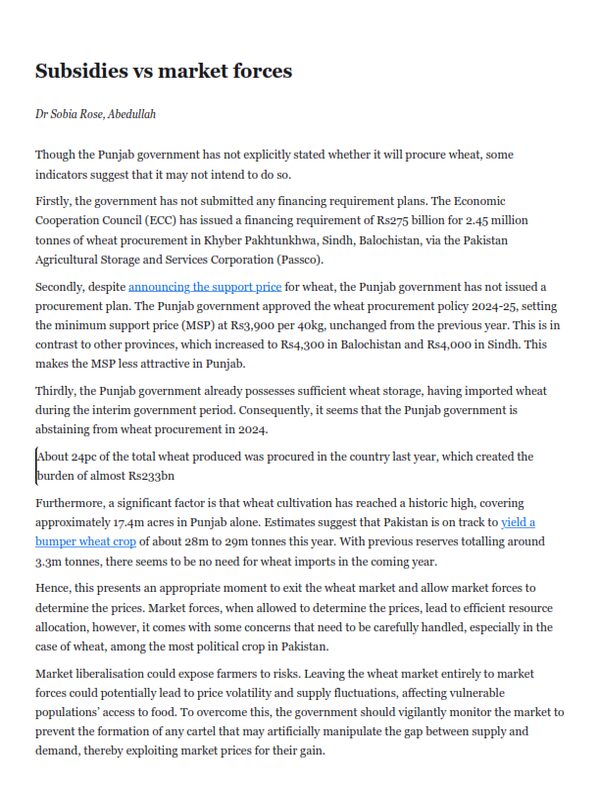Subsidies vs market forces
Though the Punjab government has not explicitly stated whether it will procure wheat, some indicators suggest that it may not intend to do so.
Firstly, the government has not submitted any financing requirement plans. The Economic Cooperation Council (ECC) has issued a financing requirement of Rs275 billion for 2.45 million tonnes of wheat procurement in Khyber Pakhtunkhwa, Sindh, Balochistan, via the Pakistan Agricultural Storage and Services Corporation (Passco).
Secondly, despite announcing the support price for wheat, the Punjab government has not issued a procurement plan. The Punjab government approved the wheat procurement policy 2024-25, setting the minimum support price (MSP) at Rs3,900 per 40kg, unchanged from the previous year. This is in contrast to other provinces, which increased to Rs4,300 in Balochistan and Rs4,000 in Sindh. This makes the MSP less attractive in Punjab.
Thirdly, the Punjab government already possesses sufficient wheat storage, having imported wheat during the interim government period. Consequently, it seems that the Punjab government is abstaining from wheat procurement in 2024.
About 24pc of the total wheat produced was procured in the country last year, which created the burden of almost Rs233bn
Furthermore, a significant factor is that wheat cultivation has reached a historic high, covering approximately 17.4m acres in Punjab alone. Estimates suggest that Pakistan is on track to yield a bumper wheat crop of about 28m to 29m tonnes this year. With previous reserves totalling around 3.3m tonnes, there seems to be no need for wheat imports in the coming year.
Hence, this presents an appropriate moment to exit the wheat market and allow market forces to determine the prices. Market forces, when allowed to determine the prices, lead to efficient resource allocation, however, it comes with some concerns that need to be carefully handled, especially in the case of wheat, among the most political crop in Pakistan.
Market liberalisation could expose farmers to risks. Leaving the wheat market entirely to market forces could potentially lead to price volatility and supply fluctuations, affecting vulnerable populations’ access to food. To overcome this, the government should vigilantly monitor the market to prevent the formation of any cartel that may artificially manipulate the gap between supply and demand, thereby exploiting market prices for their gain.
As per expectations, there are varying reactions to the Punjab government’s announcement. From the farmers’ perspective, it is viewed as unfavourable and can lead to potential protests due to the perceived inadequacy of market prices, which currently range from Rs3,100 to Rs3,600 per 40kg across different districts in Punjab.
Conversely, policy experts and those with a profound understanding of the wheat market find comfort in the Punjab Government’s decision, which will lead to better fiscal management and less debt burden.
There is a possibility that protests can compel the government to buy wheat. Therefore, a sustainable approach to this issue involves introducing gradual reforms through phased reduction of subsidies spanning over three to five years, alongside targeted support mechanisms.
The government can begin by limiting the procurement to small-scale farmers with less than five acres of land, as they constitute 64 per cent of all farmers. This approach would ensure that support benefits reach the most deserved. Following this period, the wheat market could be left entirely to market forces, with the government maintaining its sole role of managing strategic reserves to avoid any unforeseen circumstances.
Besides, this is an excellent time to leave the wheat market for several other reasons. The mechanism of support prices has not effectively stabilised local market prices nor aided low-income consumers. Instead, it created debt for the government — the Punjab government had to pay about Rs680bn. Last year, about 24pc of the total wheat produced was procured in the country which created the burden of almost Rs233bn, excluding the rental cost of the warehouse.
The government policy to take responsibility for wheat storage and then supply it to millers has resulted in multiple layers of different costs and rent-seeking opportunities. The obvious subsidy is the difference between the procured wheat price and the release price for millers. This kind of subsidy was about Rs69m in 2022.
Moreover, this rent-seeking opportunity has created excess milling capacity in the country. Only in Punjab are 1,000 flour mills that can produce about 11.5m 20kg bags daily, while the requirement is only about 2m bags per day.
If the private sector procures wheat, it won’t significantly affect consumer prices in the short term. Whether the wheat is procured by the private sector or the government, consumer prices will remain the same initially.
However, if the government stops procurement, it could save Rs233bn with no additional debt burden. Allocating this saved money for research and development, which could enhance wheat productivity over time, reducing the per-unit production cost. This, in the long run, could result in lower wheat and flour prices in the market.
Sobia Rose is a research fellow, and Abedullah is the chief of research at the Pakistan Institute of Development Economics (PIDE)
Published in Dawn, The Business and Finance Weekly, May 6th, 2024




